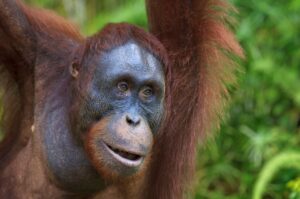“Nessie.” Generations of humans have experienced instant recognition of the moniker, the namesake lake, and the monster. But proof that the legendary Scottish monster is real or fake has slipped between our fingers.
Recently, a team of researchers brought a fresh investigation to the old mystery. Was Nessie a giant eel?
In short, probably not. In the unforgiving framework of the scientific method, disconfirmation is far more common than revelation.
Data scientist Floe Foxon of Pinney Associates and the Folk Zoology Society performed the work. It focused on the European eel (Anguilla anguilla), an ocean species that frequents Loch Ness via the source waters that connect it to open water through Inverness.

A European eel (Anguilla anguilla) and a fish. Photo: Wiki Commons
Nessie as we know him (her? They/them?) first surfaced in 1934 in the form of the alleged creature’s most famous photograph. Physician Robert Kenneth Wilson submitted that image to the Daily Mail, and the rest is history. The “Surgeon’s Photograph” is now called a hoax, based on a deathbed confession. But as any investigator knows, a confession rendered under life-threatening pressure usually won’t hold up in court.
So temporarily suspend your disbelief and allow yourself to accept the following: Nessie is a real creature that someone, at some point, saw.
What, then, did they see?
The eel theory dates to the 1970s when a zoologist named Roy Mackal became obsessed with cryptids — animals that have been claimed to exist but never proven to exist. A visit to Loch Ness convinced Mackal that massive eels drifted deep below its surface. (The University of Chicago categorized his claim as “wild speculation.”)
Still, another team picked the slippery thread back up in 2018. Geneticist Neil Gemmell of New Zealand’s Otago University led the charge, which primarily existed as a DNA sampling operation. Maybe not unsurprisingly, the team found no plesiosaur or “sea serpent” DNA, according to ScienceAlert. But they did find a lot of Anguilla anguilla DNA.
The eels were down there — this much, Foxon and his Folk Zoology Society team knew. If they could grow big enough, then it was possible they could rival Nessie’s supposed size. Ocean species, of course, don’t experience the gravitational limits of growth as strictly as land creatures.
Here’s a shocker: Size claims for Nessie vary. Consensus holds that if the Surgeon’s Photograph is in fact the monster, then it’s about two meters long. A contractor named Marmaduke Weatherell, hired to investigate by the Daily Mail in the 1930s, found what he called tracks that indicated “a very powerful soft-footed animal about 20 feet [6 meters] long.” If the 1972 Flipper Photograph was real, Nessie could be 20 meters long.
Foxon’s team chased down no less than 20,000 European eels in its study. The longest one was only a meter long. On top of that, the team estimated the physiological maximum length for the creatures at about 1.3 meters.
Maybe Nessie’s smaller than we think — or maybe we’d rather leave the facts alone and take charge of the truth ourselves. Foxon’s evidence is singularly unlikely to deter the fervor of any lathered-up Nessie believer.
View this post on Instagram
Foxon told Health Science News that the team’s work engages the topic with “a much-needed level of scientific rigor and data,” and also called it “slippery as an eel.”
Pithy stuff, in a squabble that has provoked accusations against people who have supposedly used children’s toys and household fixtures to fabricate evidence. In other camps, it’s merited long-term sonar exploration.
Nessie, if you’re down there, you’d might as well stay put. There’s not much going on up here that’s worthwhile — unless you really enjoy late-night TV on the History Channel.






